On Sunday, October 29th 2017 a high power generation from wind power plants hit low demand for electricity in Germany. Negative prices occurred over a maximum period of 21 hours, so that the production was affected by § 51 EEG 2017. Therefore, the number of negative prices rose to 103 for this year already.

On Saturday and Sunday, September 28th and 29th 2017 the prices for Germany at the day-ahead market of the EPEX Spot were below 0 EUR/MWh for a total of 31 hours. The lowest price was -83.06 EUR/MWh (cf. figure 1).

Figure 1: Electricity prices at the day-ahead market in Germany and France. Source: EPEX SPOT SE, own figure
The prices in France remained positive during this time, only settled for one hour below 20 EUR/MWh.
Wind power plants produced more than 39 gigawatts and covered 68 per cent of the demand, based on data from ENTSO-E Transparency. Onshore wind power plants generated about 36 gigawatts and offshore wind power plants about three gigawatts.
The generation of dispatchable conventional power plants decreased significantly. Hard coal power plants produced less electricity, reducing production by almost 80 % compared to the highest production on Saturday. Lignite power plants reduced the output from 15.7 gigawatts to 5.5 gigawatts until Monday and increased production Monday evening.
The reduction of generation by nuclear power amounted to three gigawatts (minus 37 per cent compared to the maximum daily value). This corresponds to the capacity of three nuclear power plants. Pump storage used about three gigawatts of generation for storing electricity. There was no significant reduction of biomass plants (minus 2 per cent) according to the data of ENTSO-E Transparency but run-of-river (minus 15 per cent) and waste energy (minus 59 per cent, resulting in two gigawatts reduction) reduced their power output significantly. This is a remarkable increase compared the situation on 11th September.
Figure 2 shows the generation and the demand on Sunday and Monday in Germany.
On both days, Germany continuously exported electricity. Up to 11 gigawatts could be distributed to other countries. Figure 3 shows the development of net imports of Germany (negative values represent exports). Physical cross-border flows are actual electricity flows between countries, due to electricity generation and consumption of the European countries.

Figure 3: Balance of imports and exports in Germany. Source: ENTSO-E Transparency, physical flows, own figure
What are negative electricity prices? EPEX SPOT defines them as follows: “Negative prices are a price signal on the power wholesale market that occurs when a high inflexible power generation meets low demand. Inflexible power sources can’t be shut down and restarted in a quick and cost-efficient manner. Renewables do count in, as they are dependent from external factors (wind, sun).”
Negative prices therefore are not caused by a surplus generation of renewable energies, but due to the lack of flexibility of nuclear power plants, lignite power plants and combined-heat and power plants (CHP-plants).
Note:
Generation, demand and physical flows are based on real time values whereas the spot market prices in figure 1 show day-ahead values, based on forecasts. Because of balancing and intraday markets as well as unexpected developments, the power system data cannot be solely used to interpret and explain the day ahead prices.
Generation data from ENTSO-E Transparency is not complete. Data for generation from hard coal and gas power stations is only covering a small part of the overall generation, compared to other available sources, which are unfortunately not available in hourly resolution.




